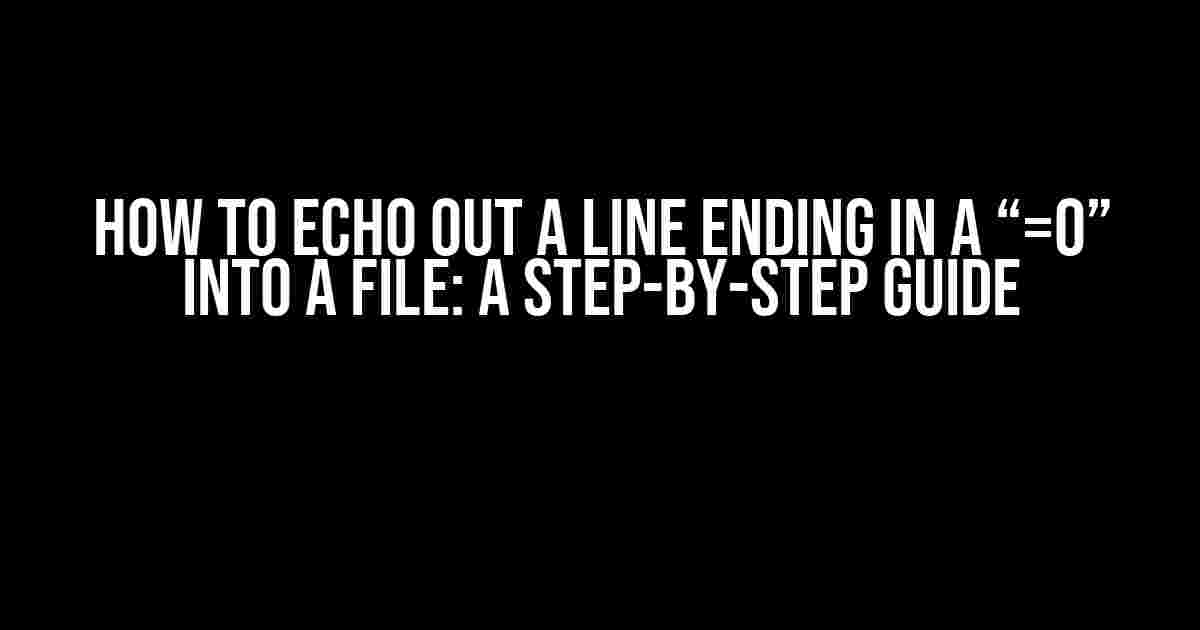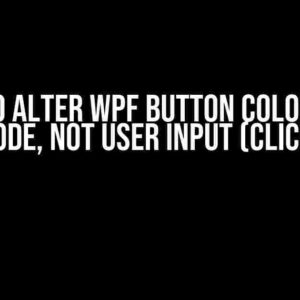Are you tired of struggling to echo out a line ending in a “=0” into a file? Do you find yourself stuck in a loop of trial and error, trying to get the syntax just right? Fear not, dear developer, for we have got you covered! In this comprehensive guide, we’ll take you by the hand and walk you through the process of echoing out a line ending in a “=0” into a file, with ease and simplicity.
Why Do We Need to Echo Out a Line Ending in a “=0”?
In many programming languages, including PHP, Python, and Java, echoing out a line ending in a “=0” is a common task. This is often required when working with configuration files, data storage, or even simple logging. The “=0” appendage is used to indicate the end of a line, making it easier to parse and analyze the data.
The Problem: Why It’s Not as Simple as It Seems
So, why is it so hard to echo out a line ending in a “=0”? You’d think it’s as simple as typing `echo “line=0″` into your code, but alas, it’s not that straightforward. The issue lies in the way quotation marks and escape characters are handled by different programming languages.
In PHP, for example, the `echo` function will not interpret the `=` symbol as a literal character, but rather as an assignment operator. This means that `echo “line=0″` will not produce the desired output, but rather throw an error.
The Solution: How to Echo Out a Line Ending in a “=0”
Fear not, dear reader, for we have a solution for you! Here are the step-by-step instructions to echo out a line ending in a “=0” into a file:
### Using PHP
<?php
$file = 'path/to/your/file.txt';
$line = 'line=0';
file_put_contents($file, $line . PHP_EOL, FILE_APPEND);
?>In this example, we use the `file_put_contents` function to append the line to the file. The `PHP_EOL` constant is used to add a newline character to the end of the line, and the `FILE_APPEND` flag ensures that the line is appended to the end of the file.
### Using Python
with open('path/to/your/file.txt', 'a') as f:
f.write('line=0\n')In Python, we use the `with` statement to open the file in append mode (`’a’`). The `write` method is then used to write the line to the file, with the `\n` character adding a newline at the end.
### Using Java
import java.io.FileWriter;
import java.io.IOException;
public class Main {
public static void main(String[] args) throws IOException {
String file = "path/to/your/file.txt";
String line = "line=0";
FileWriter writer = new FileWriter(file, true);
writer.write(line + System.getProperty("line.separator"));
writer.close();
}
}In Java, we use the `FileWriter` class to write to the file. The `true` argument in the constructor tells Java to append to the file instead of overwriting it. The `write` method is then used to write the line, with `System.getProperty(“line.separator”)` adding the platform-dependent newline character.
Troubleshooting Common Issues
While the above solutions should work in most cases, you may encounter some common issues. Here are some troubleshooting tips to help you out:
- Permission Issues: Make sure you have the necessary permissions to write to the file and folder.
- File Encoding: Ensure that the file encoding matches the encoding of your code (e.g., UTF-8).
- Newline Characters: Be aware of the newline characters used by your operating system (e.g., `\n` on Unix-based systems, `\r\n` on Windows).
- Special Characters: If your line contains special characters (e.g., quotes, backslashes), make sure to escape them properly.
Conclusion
And there you have it, folks! With these step-by-step instructions, you should now be able to echo out a line ending in a “=0” into a file with ease. Remember to choose the correct programming language and approach for your specific needs, and don’t hesitate to reach out if you encounter any issues.
| Language | Solution |
|---|---|
| PHP | <?php ... ?> |
| Python | with open ... |
| Java | FileWriter writer ... |
By following this guide, you’ll be well on your way to mastering the art of echoing out lines ending in a “=0” into files. Happy coding!
FAQs
- Q: Can I use this method for other types of files?
A: Yes, this method can be used for any type of file, provided you have the necessary permissions and encoding matches.
- Q: What if I want to append multiple lines to the file?
A: Simply repeat the process for each line you want to append, or use a loop to iterate over an array of lines.
- Q: Can I use this method in other programming languages?
A: Yes, the concept of echoing out a line ending in a “=0” into a file can be applied to other programming languages, with slight modifications to the syntax.
We hope this comprehensive guide has helped you overcome the hurdle of echoing out a line ending in a “=0” into a file. If you have any further questions or concerns, please don’t hesitate to reach out.
Frequently Asked Question
Get the inside scoop on how to echo out a line ending in a “=” into a file!
Q1: How do I prevent the “=” from being interpreted as a variable assignment?
You can use quotes around the string, like this: `echo “myvariable=0” >> myfile.txt`. The quotes ensure that the “=” is treated as a literal character, rather than an assignment operator.
Q2: What’s the difference between `>` and `>>` when redirecting output to a file?
The `>` symbol overwrites the file, while the `>>` symbol appends to the file. So, if you want to add a new line to an existing file, use `>>`. If you want to start fresh, use `>`. In this case, `>>` is the way to go!
Q3: Can I use single quotes instead of double quotes?
Yes, you can! In this case, `echo ‘myvariable=0’ >> myfile.txt` would work just as well. However, keep in mind that single quotes treat the string as literal, while double quotes allow for variable expansion. So, if you need to use variables in your string, double quotes are the way to go!
Q4: What if I want to add multiple lines to the file, each ending with “=0”?
Easy peasy! You can use a loop or an array to generate multiple lines. For example: `for i in {1..5}; do echo “myvariable$i=0” >> myfile.txt; done`. This would add five lines to the file, each with a unique variable name and “=0” at the end.
Q5: Can I use this method to append to a file in a specific directory?
Absolutely! Just specify the full path to the file, like this: `echo “myvariable=0” >> /path/to/myfile.txt`. Make sure you have write permissions to the directory, and you’re good to go!




